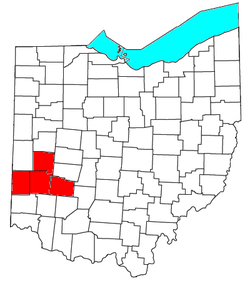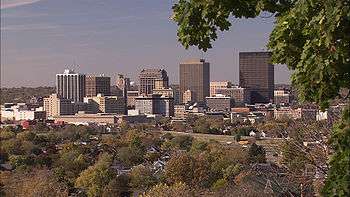Dayton metropolitan area
| Metro Dayton, The Miami Valley, Greater Dayton | |
|---|---|
| Dayton | |
 The Dayton Metropolitan Area. | |
| Country | United States |
| State(s) | Ohio |
| Largest city | Dayton |
| Other cities |
- Kettering - Centerville |
| Area | |
| • Total | 1,715 sq mi (4,440 km2) |
| Population | |
| • Total | 799,232 |
| • Rank | 61 st in the U.S. |
| • Density | 478/sq mi (185/km2) |
The Dayton metropolitan area is the metropolitan area centered on Dayton, Ohio. It is the fourth largest metropolitan area in the state of Ohio, behind Cincinnati, Cleveland, and Columbus.
Definitions
Dayton Metropolitan Area (also known as Greater Dayton), as defined by the United States Census Bureau, is an area consisting of three counties in the Miami Valley region of Ohio and is anchored by the city of Dayton. As of 2000 it is the fourth largest metropolitan area in Ohio and the 61st largest Metropolitan Area by Population in the United States. As of the 2010 census, the MSA had a population of 799,232 based on a change in MSA defining criteria as of 2013, which eliminated Preble County. This exclusion was applied retroactively to the 2010 population figures.[1]
The Dayton-Springfield-Greenville-Sidney Combined Statistical Area is a CSA in the U.S. state of Ohio, as defined by the United States Census Bureau. It consists of the Dayton Metropolitan Statistical Area (the counties of Montgomery, Greene and Miami); the Springfield Metropolitan Statistical Area (Clark County); the Urbana Micropolitan Statistical Area (Champaign County); the Greenville Micropolitan Statistical Area (Darke County); and the Sidney Micropolitan Statistical Area (Shelby County). As of the 2010 Census, the CSA had a population of 1,080,044.
- Metropolitan Statistical Areas (MSAs)
- Dayton (Greene, Miami, and Montgomery counties)
- Springfield (Clark County)
- Micropolitan Statistical Areas (μSAs)
- Greenville (Darke County)
- Urbana (Champaign County)
- Sidney (Shelby County)
According to an article in the Cincinnati Enquirer, as Greater Cincinnati grows northward through Butler County, its outer suburbs are expected to expand and begin to overlap the Greater Dayton area.[2] Such a concept has already received the nickname of "Daytonnati."[3] The two metropolitan areas were expected to be combined after tabulation of the 2010 Census, but this did not occur.
The Dayton Metropolitan area is part of the Great Lakes Megalopolis containing an estimated 54 million people.
Counties
Cities
Suburban communities greater than 30,000
- Beavercreek - 45,193
- Fairborn - 32,352
- Huber Heights - 38,101
- Kettering - 56,163
Montgomery County

Greene County
Miami County
|
Places with fewer than 1,000 inhabitants
- Bowersville
- Casstown
- Clifton (partial)
- College Corner (partial)
- Eldorado
- Farmersville
- Fletcher
- Gratis
- Laura
- Ludlow Falls
- Phillipsburg
- Potsdam
- Spring Valley
- Verona
- West Elkton
- West Manchester
Unincorporated places
- Brandt
- Byron
- Chautauqua (partial)
- Conover
- Fairhaven
- Morning Sun
- New Hope
- Phoneton
- Pyrmont
- West Charleston
Townships
Greene County

- Bath Township
- Beavercreek Township
- Caesarscreek Township
- Cedarville Township
- Jefferson Township
- Miami Township
- New Jasper Township
- Ross Township
- Silvercreek Township
- Spring Valley Township
- Sugarcreek Township
- Xenia Township
Miami County
- Bethel Township
- Brown Township
- Concord Township
- Elizabeth Township
- Lostcreek Township
- Monroe Township
- Newberry Township
- Newton Township
- Springcreek Township
- Staunton Township
- Union Township
- Washington Township
Montgomery County
- Butler Township
- Clay Township
- German Township
- Harrison Township
- Jackson Township
- Jefferson Township
- Miami Township
- Perry Township
- Washington Township
Demographics
| Historical population | |||
|---|---|---|---|
| Census | Pop. | %± | |
| 1900 | 161,759 | — | |
| 1910 | 193,496 | 19.6% | |
| 1920 | 289,181 | 49.5% | |
| 1930 | 358,041 | 23.8% | |
| 1940 | 383,975 | 7.2% | |
| 1950 | 545,723 | 42.1% | |
| 1960 | 727,121 | 33.2% | |
| 1970 | 850,266 | 16.9% | |
| 1980 | 830,070 | −2.4% | |
| 1990 | 843,835 | 1.7% | |
| 2000 | 848,153 | 0.5% | |
| 2010 | 799,232 | −5.8% | |
| Population 1990-2010 with 2011 estimate.[4][5] | |||
As of the census 2010, there were 799,232 people, 343,971 households, and 220,249 families residing within the MSA. The racial makeup of the MSA was 80.40% White, 14.90% African American, 0.20% Native American, 1.80% Asian, 0.01% Pacific Islander, 0.80% from other races, and 2.00% from two or more races. Hispanic or Latino of any race were 1.90% of the population.[6]
The median income for a household in the MSA was $47,381, and the median income for a family was $59,770. Males had a median income of $38,430 versus $26,205 for females. The per capita income for the MSA was $25,436.[7]
From the 2000 Census to the 2010 Census, the Dayton region has seen a shift in population from its urban core to more out-lying affluent suburbs. This is evidenced by a 10% growth in population in Englewood, a 19% population growth in Beavercreek, and a 40% population growth in Springboro. Smaller growths in the 2010 census in the Dayton area included Miamisburg, Centerville, Vandalia, and Fairborn. Many of Dayton's suburbs that saw declines in populations fared well from 2000 to 2010. Dayton's largest suburb, Kettering for example, only saw a 2.3% decline during the ten-year period and Huber Heights, Dayton's third largest suburb, saw a 0.3% decline in population.
The Dayton Metropolitan Statistical Area formerly included Clark County and Preble County. In 2005, Clark County containing Springfield, Ohio separated from the Dayton MSA to create their own MSA named Springfield Metropolitan Statistical Area. As a result of new Census criteria to delineate metropolitan areas, Preble County was eliminated from the MSA in 2013 as it no longer qualified for inclusion. A significant drop in population for the Dayton MSA is noted in the 2010 census because of these changes.[8]
Colleges and universities
The Greater Dayton region is home to a number of higher education facilities, including:
- Air Force Institute of Technology (Wright-Patterson AFB)
- Antioch College (Yellow Springs)
- Cedarville University (Cedarville)
- Central State University (Wilberforce)
- Kettering College of Medical Arts (Kettering)
- Sinclair Community College (Dayton)
- University of Dayton (Dayton)
- Wilberforce University (Wilberforce)
- Wittenberg University (Springfield)
- Wright State University (Fairborn)
Largest employers
Notable largest employers in the Dayton region :[9]
- Wright-Patterson Air Force Base 27,406
- Premier Health Partners 14,335
- Kettering Health Network 9,500
- Miami University 4,438
- Wright State University 3,095
- LexisNexis 3,000
- University of Dayton 2,978
- Honda Manufacturing of America 2,940
- AK Steel Holding 2,500
Transportation
Airports
Greater Dayton is served by international, regional and county airports, including:
- Dahio Trotwood Airport
- Dayton International Airport
- Dayton-Wright Brothers Airport
- Greene County-Lewis A. Jackson Regional Airport
- Moraine Airpark
- Wright-Patterson Air Force Base
Major highways
-
 Interstate 70
Interstate 70 -
 Interstate 71
Interstate 71 -
 Interstate 75
Interstate 75 -
 Interstate 675
Interstate 675 -
 U.S. Route 35
U.S. Route 35 -
 U.S. Route 36
U.S. Route 36 -
 U.S. Route 40
U.S. Route 40 -
 U.S. Route 42
U.S. Route 42 -
 U.S. Route 68
U.S. Route 68 -
 State Route 4
State Route 4 -
 State Route 41
State Route 41 -
 State Route 49
State Route 49 -
 State Route 202
State Route 202 -
 State Route 235
State Route 235 -
 State Route 444
State Route 444 -
 State Route 725
State Route 725 -
 State Route 741
State Route 741 -
 State Route 844
State Route 844
Public transit
The Greater Dayton Regional Transit Authority operates a public busing system in Montgomery county. Other transit agencies serve the surrounding counties and provide connections with RTA, including transit authorities in Greene and Miami counties.
Culture
Museums
- Dayton Art Institute (Dayton)
- Boonshoft Museum of Discovery (Dayton)
- America's Packard Museum (Dayton)
- National Museum of the United States Air Force (Riverside)
Theaters
In addition to Benjamin and Marian Schuster Performing Arts Center, the Dayton Region's largest performing arts center, Greater Dayton has a vibrant theater community throughout the region.
- Actors Theater (Fairborn)
- Beavercreek Community Theatre (Beavercreek)[10]
- Benjamin and Marian Schuster Performing Arts Center (Dayton)[11]
- Brookville Community Theater (Brookville)[12]
- Dayton Playhouse (Dayton)[13]
- La Comedia Dinner Theatre (Springboro)
- Loft Theatre (Dayton)[14]
- Progressive Dance Theater (Dayton)[15]
- Town Hall Theatre (Centerville)[16]
- Victoria Theatre (Dayton)[14]
Theatrical companies
- Dayton Ballet[17]
- Dayton Contemporary Dance Company[15]
- Dayton Opera Associates[18]
- Dayton Theatre Guild[19]
- Human Race Theatre Company[20]
- Victoria Theatre Association[14]
See also
- Miami Valley
- Ohio census statistical areas
- List of United States metropolitan statistical areas by population
External links
References
- ↑ "American FactFinder2". Retrieved 2010-03-20.
- ↑ "Cinci-Dayton? | Cincinnati.com | cincinnati.com". News.enquirer.com. Retrieved 2015-12-24.
- ↑ Ready for `Daytonnati?' It could happen
- ↑ "Census Of Population 1990-2000". U.S. Census Bureau. Retrieved 2012-10-08.
- ↑ "Census Of Population 2010 with 2011 estimate". U.S. Census Bureau. Retrieved 2012-10-08.
- ↑ "U.S. Census FactFinder populations". U.S. Census Bureau. Retrieved 2012-10-08.
- ↑ "U.S. Census FactFinder incomes". U.S. Census Bureau. Retrieved 2012-10-08.
- ↑ "Springfield separates from Dayton MSA". Dayton Business Journal. Retrieved 2012-10-08.
- ↑ "Dayton Economy Employers and Employees". June 25, 2009.
- ↑ Beavercreek Community Theatre. Bctheatre.org. Retrieved on 2013-07-17.
- ↑ Benjamin & Marian Schuster Performing Arts Center
- ↑ Brookville Community Theatre
- ↑ Welcome to the Frontpage
- 1 2 3 Victoria Theatre Association - Broadway in Dayton
- 1 2 DCDC - Dayton Contemporary Dance Company
- ↑ Washington Township
- ↑ Dayton Ballet
- ↑ Dayton Opera
- ↑ Dayton Theatre Guild
- ↑ Welcome to The Human Race Theatre Company